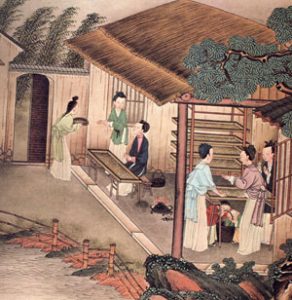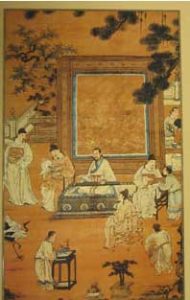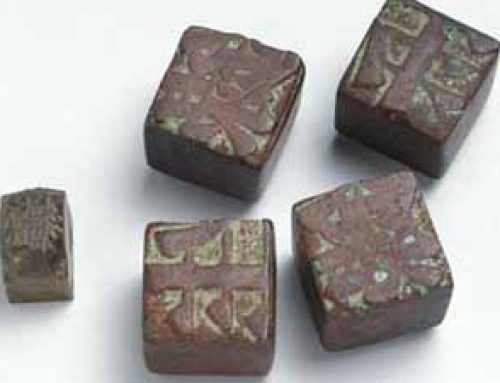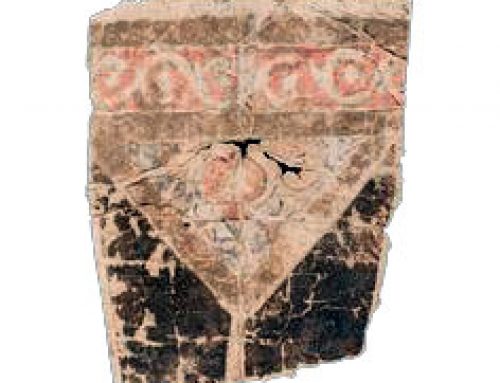
People in ancient China: Rich men hunt, but other people work in the fields (Han Dynasty, about 100 AD)
Differences between people in ancient China
People in ancient China always put a lot of emphasis on everybody acting the right way for their position in life. People thought poor people should act different from rich people, and women should act different from men. City people should act different from country people (compare this to the Indian caste system, or European feudalism).
Families in ancient China
In China, people thought your most important relationship was with your family. Kids often lived in the same house not just with their parents, but also with their grandparents, their aunts and uncles, and their cousins. People thought that family was much more important than friends.

Women working in a silk factory
Did kids go to school in ancient China?
Most boys and girls in China did not go to school. They worked on their parents’ farms, pulling weeds and planting seeds. Even rich girls did not go to school, but boys from rich families did. The boys worked very hard at school, because doing well on the state examinations was the only way to get political power.
Marriage in ancient China
When girls grew up, they got married and left the house they had grown up in to go live in their husband’s house, with his family. This was often hard, because girls got married young, and when they went to live in their husband’s house they had to do whatever his mother told them to do.

Chinese school (actually from the 1500s AD)
Did ancient China have slavery?
But the lives of enslaved people were the hardest of all. Many Chinese people were slaves. Most people who were slaves worked in the fields, the same as free people. Some slaves worked as servants in rich people’s houses.
The Emperor owned hundreds of slaves, and some of them worked for the government, collecting taxes or building roads. Some people were born slaves, because their mothers were slaves, and other people were sold into slavery to pay debts.
Often, as in India and West Asia, children were sold into slavery to pay off their parents’ debts.
Did you find out what you wanted to know about people in ancient China? Let us know in the comments!
Learn by doing: Chinese foot-binding project
Women in ancient China
Ancient Chinese schools
Bibliography and further reading about Chinese people:
Eyewitness: Ancient China, by Arthur Cotterell, Alan Hills, and Geoff Brightling (2000). , with lots of excellent pictures.
Daily Life in China, on the Eve of the Mongol Invasion, 1250-1276, by Jacques Gernet (1962).
The Inner Quarters: Marriage and the Lives of Chinese Women in the SungPeriod, by Patricia Buckley Ebrey (1993).
Women of the Tang Dynasty, by May Holdsworth (1999). A short introduction, with many pictures of T’ang period figurines.





you safe my life with this website!!!!!!!!!!!!!!!!!!!!!!!!!!!!!!!!!!!!!!!!!!!!!!!!!!!!!!!!!!!!!!!!!!!!!!!!!!!!!!!!!!!!!!!!!!!!!!!!!!!!!!!!!!!!!!!!!!!!!!!!!!!!!!!!!!!!!!!!!!!!!!!!!!!!!!!!!!!!!!!!!!!!!!!!!!!!!THANK YOU;)!!!!!!!!!!!!!!!!!!!!!!!!!!!!!!!!!!!!!!!!!!!!!!!!!!!!!!!!!!!!!!!!!!!!!!!!!!!!!!!!!!!!!!!!!!!!!!!!!!!!!!!!!!!!!!!!!!!!!!!!!!!!!!!!!!!!!!!!!!!!!!!!!!!!!!!!!!!!!!!!!!!!!!!!!!!!!!!!!!!!!!!!!!!!!!!!!!!!!!!!!!!!!!!!!!!!!!!!!!!!!TT.TT
You’re welcome, Katie! I’m glad we could help.
This was really helpful! Thanks
im tom
Hi Tom! Thanks for stopping by.
lol
Can you also recommend me websites that you wrote? Thanks!
Hi Iris! I wrote most of the articles on https://quatr.us – is that what you meant?
Love this! Got an A plus thanks to his website
And to your own hard work! Good job, Iris!